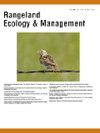Ecosystem Dynamics in Wet Heathlands: Spatial and Temporal Effects of Environmental Drivers on the Vegetation
IF 2.4
3区 环境科学与生态学
Q2 ECOLOGY
引用次数: 0
Abstract
To understand and estimate the effects of environmental drivers on temperate wet heathland vegetation, pin-point cover data from 42 Danish sites sampled during a 15-year period was regressed onto selected environmental variables. The effects of nitrogen deposition, soil pH, soil C–N ratio, soil type, precipitation, and grazing on the heathland vegetation was modeled in a spatiotemporal structural equation model using a Bayesian hierarchical model structure. The results suggest that the modeled environmental variables have various regulating effects on the large-scale spatial variation as well as plant community dynamics in wet heathlands. Most noticeably, nitrogen deposition and yearly precipitation had relatively large and opposite temporal effects on the characteristic species Erica tetralix and Molinia caerulea, where nitrogen deposition had negative effects on E. tetralix and positive effects on M. caerulea. The results of this study differed in important qualitative aspects from the findings of an earlier study where comparable data from a shorter time series (7 years instead of 15 years) were analyzed with a similar model, which suggests that relatively long time series are needed for studying ecosystem dynamics. Furthermore, it was concluded that the effect of nitrogen deposition on plant community dynamics mainly was through direct effects, whereas the effect of soil type on plant community dynamics was both direct and indirect mediated by the effect of soil type on soil pH. It was concluded that the modeled environmental variables are sufficient for predicting the average plant community dynamics of wet heathlands. However, caution is required if the fitted model is used for generating local ecological predictions as input to a process of generating adaptive management plans for specific wet heathland sites. Moreover, the results suggest that the ratio between the two species E. tetralix and M. caerulea may be used as an indicator for the conservation status of wet heathlands.
湿荒原生态系统动态:环境驱动因素对植被的时空影响
为了了解和估计环境驱动因素对温带湿石楠草原植被的影响,对丹麦42个地点取样的15年期间的定点覆盖数据进行了回归,并选择了环境变量。采用贝叶斯层次模型结构,建立了氮沉降、土壤pH、土壤C-N比、土壤类型、降水和放牧对石南荒原植被的影响时空结构方程模型。结果表明,模拟的环境变量对湿石南荒原大尺度空间变化和植物群落动态具有不同的调节作用。最明显的是,氮沉降和年降水量对特征物种四联禾和小叶毛茅的时间效应相对较大且相反,其中氮沉降对四联禾的影响为负,对小叶毛茅的影响为正。这项研究的结果在重要的定性方面与早期研究的结果不同,在早期研究中,使用类似的模型分析了较短时间序列(7年而不是15年)的可比数据,这表明研究生态系统动力学需要相对较长的时间序列。此外,氮沉降对植物群落动态的影响主要是通过直接效应,而土壤类型对植物群落动态的影响是由土壤类型对土壤ph的影响直接和间接介导的。由此得出,模拟的环境变量足以预测湿石南荒原的平均植物群落动态。但是,如果将拟合模型用于生成当地生态预测,作为为特定湿石楠地生成适应性管理计划过程的输入,则需要谨慎。此外,研究结果还表明,四联禾与毛蕊禾的比值可以作为湿石南保护状况的一个指标。
本文章由计算机程序翻译,如有差异,请以英文原文为准。
求助全文
约1分钟内获得全文
求助全文
来源期刊

Rangeland Ecology & Management
农林科学-环境科学
CiteScore
4.60
自引率
13.00%
发文量
87
审稿时长
12-24 weeks
期刊介绍:
Rangeland Ecology & Management publishes all topics-including ecology, management, socioeconomic and policy-pertaining to global rangelands. The journal''s mission is to inform academics, ecosystem managers and policy makers of science-based information to promote sound rangeland stewardship. Author submissions are published in five manuscript categories: original research papers, high-profile forum topics, concept syntheses, as well as research and technical notes.
Rangelands represent approximately 50% of the Earth''s land area and provision multiple ecosystem services for large human populations. This expansive and diverse land area functions as coupled human-ecological systems. Knowledge of both social and biophysical system components and their interactions represent the foundation for informed rangeland stewardship. Rangeland Ecology & Management uniquely integrates information from multiple system components to address current and pending challenges confronting global rangelands.
 求助内容:
求助内容: 应助结果提醒方式:
应助结果提醒方式:


